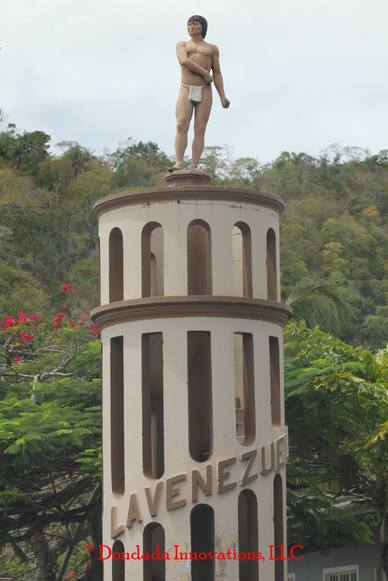 If you have ever driven up Santa Cruz Old Road and saw this statue, La Venezuela but never knew the history behind it, here it is San Juan and Santa Cruz were born of the Spanish colonisation of Trinidad. In the 1790s, Don Jose Maria Chacon, the last Spanish Governor of Trinidad, established the settlement of San Juan de Aricagua, after a nearby river that still carries the name. Santa Cruz (Holy Cross), on the other hand, was first settled around 1785, when large land grants were made to Spanish nationals for cultivating cocoa and coffee. LAA de Verteuil, a Frenchman, had described Santa Cruz as having "the richest and largest estates in Trinidad. The valley of Santa Cruz branches off into several smaller glens, each being irrigated by its respective stream which carries off water to the Aricagua (San Juan) river". When the lands were granted to the Spaniards, the beleaguered Amerindians were not happy about the invasion of their territory by foreigners, and to keep control they frequently attacked and killed the Spaniards. This resistance by the Amerindians had started since the 16th century, when Don Antonio Sedeno was attacked and repulsed at Mucurapo. As the resistance continued there was an attack on St Joseph in 1637 by Hyarima, a cacique of the Nepuyo tribe. Again in 1699 there was the killing of three Capuchin monks and a Spanish governor. The event was called the Arena Massacre. The Amerindians, in the end, would be wiped out by the Spaniards. However, the relationship between the Spaniards and Amerindians was not altogether hostile. Within the tribe there were those who cooperated with the Spaniards. One such was a friendly male Amerindian who was killed by his tribesmen for warning Spanish settlers about an impending attack on their settlement at Santa Cruz. An image of that Amerindian is atop a 20-foot-high cylindrical concrete tower on the Santa Cruz Old Road, with the words "La Venezuela" inscribed around the pedestal. The concrete statue, painted in bronze, is located on the northern edges of San Juan, about two miles from the town centre. Although most of the residents at Santa Cruz Old Road are familiar with the statue, they are not sure when it was erected. "Oral traditions indicate there was a Spanish settlement in the area and the settlers had developed friendly relationships with the Amerindians. Unfortunately, the relationship deteriorated over time, and an attack on the Spaniards by the Amerindians was contemplated. But before the attack the Spaniards were warned by a male Amerindian, and they fled from the area. "In gratitude for the warning, the original Spanish settlers at Santa Cruz Old Road erected the statue when the area was not yet developed," one resident said. Villagers recalled that the Amerindian had a bow and arrow in his hands, "but some unscrupulous persons removed it". Another resident said, "At the base of the pedestal there was an escape tunnel leading to the San Juan River, which is approximately 500 feet from the pedestal. The tunnel was used by the Spaniards to escape from the area, if ever they were attacked." The statue has been a landmark for several years. Residents said when construction of houses began in the area, many Spanish artefacts, including a musket, were found. The statue is not the only item of historical interest at La Venezuela Gardens. There is also an old gazebo and a concrete structure looking like a large table that were used for community dining. Santa Cruz Old Road is one of the popular accesses from San Juan to the Santa Cruz valley. After travelling for two miles on the narrow winding road it merges with the Santa Cruz Main Road. The Santa Cruz valley was one of the newest cocoa plantations in Trinidad. By 1890, the valley was at the height of prosperity. The French creoles had purchased many of the smaller estates and made them large enough to support their families. Before changes were made to the environment, the valley was graced with spreading trees and giant clumps of bamboos arched overhead and rivulets ran beside the road and among dark cocoa plantations where the air was moist and sweet. The area now called La Venezuela Gardens was part of that glorious past. Source: Virtual Museum of T&T and the Trinidad Express
3 Comments
renee cushmeer
7/24/2021 04:11:01 pm
thanks for explaining the statue.. nice read
Reply
Avram
3/19/2023 08:54:55 pm
I am so very thankful to you for posting this information. Many in the area had no idea about the statue.
Reply
12/14/2023 10:11:23 am
I spent three wonderful weeks in Trinidad and Tobago in October 2023. I had the opportunity to go on a hike to a waterfall in Las Cuevas. It was a most enjoyable and memorable experience. On my way home we passed through Santa Cruz and Santa Cruz Old Road where my grandmother and aunts lived. This is where I saw and was given a little history of The Venezuelan. Thank you for sharing with us.
Reply
Leave a Reply. |
T&T news blogThe intent of this blog is to bring some news from home and other fun items. If you enjoy what you read, please leave us a comment.. Archives
July 2025
Categories
All
|

 RSS Feed
RSS Feed